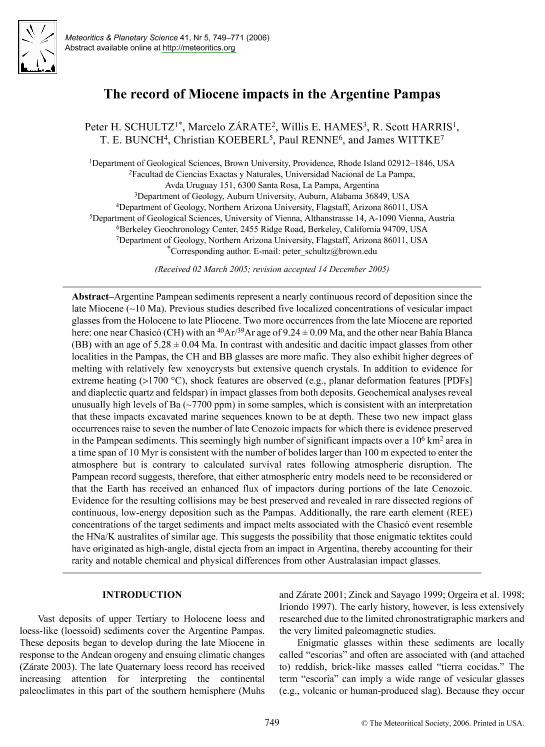Mostrar el registro sencillo del ítem
dc.contributor.author
Schultz, Peter H.
dc.contributor.author
Zárate, Marcelo Arístides

dc.contributor.author
Hames, Willis E.
dc.contributor.author
Harris, R. Scott
dc.contributor.author
Bunch, T. E.
dc.contributor.author
Koeberl, Christian
dc.contributor.author
Renne, Paul
dc.contributor.author
Wittke, James
dc.date.available
2019-08-20T19:56:54Z
dc.date.issued
2004-03
dc.identifier.citation
Schultz, Peter H.; Zárate, Marcelo Arístides; Hames, Willis E.; Harris, R. Scott; Bunch, T. E.; et al.; The record of miocene impacts in the Argentine Pampas; Wiley; Meteoritics & Planetary Science; 41; 5; 3-2004; 749-771
dc.identifier.issn
1086-9379
dc.identifier.uri
http://hdl.handle.net/11336/81867
dc.description.abstract
Argentine Pampean sediments represent a nearly continuous record of deposition since the late Miocene (∼ 10 Ma). Previous studies described five localized concentrations of vesicular impact glasses from the Holocene to late Pliocene. Two more occurrences from the late Miocene are reported here: one near Chasicó (CH) with an 40Ar/39Ar age of 9.24 ± 0.09 Ma, and the other near Bahía Blanca (BB) with an age of 5.28 ± 0.04 Ma. In contrast with andesitic and dacitic impact glasses from other localities in the Pampas, the CH and BB glasses are more mafic. They also exhibit higher degrees of melting with relatively few xenoycrysts but extensive quench crystals. In addition to evidence for extreme heating (>1700 °C), shock features are observed (e.g., planar deformation features [PDFs] and diaplectic quartz and feldspar) in impact glasses from both deposits. Geochemical analyses reveal unusually high levels of Ba (∼7700 ppm) in some samples, which is consistent with an interpretation that these impacts excavated marine sequences known to be at depth. These two new impact glass occurrences raise to seven the number of late Cenozoic impacts for which there is evidence preserved in the Pampean sediments. This seemingly high number of significant impacts over a 106 km2 area in a time span of 10 Myr is consistent with the number of bolides larger than 100 m in expected to enter the atmosphere but is contrary to calculated survival rates following atmospheric disruption. The Pampean record suggests, therefore, that either atmospheric entry models need to be reconsidered or that the Earth has received an enhanced flux of impactors during portions of the late Cenozoic. Evidence for the resulting collisions may be best preserved and revealed in rare dissected regions of continuous, low-energy deposition such as the Pampas. Additionally, the rare earth element (REE) concentrations of the target sediments and impact melts associated with the Chasicó event resemble the HNa/K australites of similar age. This suggests the possibility that those enigmatic tektites could have originated as high-angle, distal ejecta from an impact in Argentina, thereby accounting for their rarity and notable chemical and physical differences from other Australasian impact glasses.
dc.format
application/pdf
dc.language.iso
eng
dc.publisher
Wiley

dc.rights
info:eu-repo/semantics/openAccess
dc.rights.uri
https://creativecommons.org/licenses/by-nc-sa/2.5/ar/
dc.subject
Argentina
dc.subject
Escoria
dc.subject
Impact Glass
dc.subject
Loess
dc.subject
Pampasites
dc.subject
Tektites
dc.subject.classification
Geología

dc.subject.classification
Ciencias de la Tierra y relacionadas con el Medio Ambiente

dc.subject.classification
CIENCIAS NATURALES Y EXACTAS

dc.title
The record of miocene impacts in the Argentine Pampas
dc.type
info:eu-repo/semantics/article
dc.type
info:ar-repo/semantics/artículo
dc.type
info:eu-repo/semantics/publishedVersion
dc.date.updated
2019-08-15T16:21:37Z
dc.journal.volume
41
dc.journal.number
5
dc.journal.pagination
749-771
dc.journal.pais
Estados Unidos

dc.journal.ciudad
Hoboken
dc.description.fil
Fil: Schultz, Peter H.. Brown University; Estados Unidos
dc.description.fil
Fil: Zárate, Marcelo Arístides. Consejo Nacional de Investigaciones Científicas y Técnicas. Instituto de Ciencias de la Tierra y Ambientales de La Pampa. Universidad Nacional de La Pampa. Facultad de Ciencias Exactas y Naturales. Instituto de Ciencias de la Tierra y Ambientales de La Pampa; Argentina
dc.description.fil
Fil: Hames, Willis E.. Auburn University; Estados Unidos
dc.description.fil
Fil: Harris, R. Scott. Brown University; Estados Unidos
dc.description.fil
Fil: Bunch, T. E.. Northern Arizona; Estados Unidos
dc.description.fil
Fil: Koeberl, Christian. Universidad de Viena; Austria
dc.description.fil
Fil: Renne, Paul. Berkeley Geochronology Center; Estados Unidos
dc.description.fil
Fil: Wittke, James. Northern Arizona University; Estados Unidos
dc.journal.title
Meteoritics & Planetary Science

dc.relation.alternativeid
info:eu-repo/semantics/altIdentifier/doi/https://doi.org/10.1111/j.1945-5100.2006.tb00990.x
dc.relation.alternativeid
info:eu-repo/semantics/altIdentifier/url/https://onlinelibrary.wiley.com/doi/abs/10.1111/j.1945-5100.2006.tb00990.x
Archivos asociados
